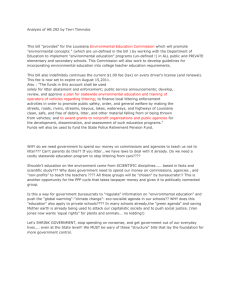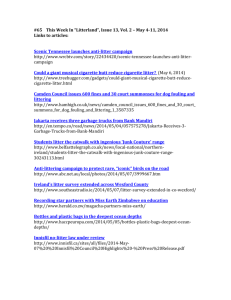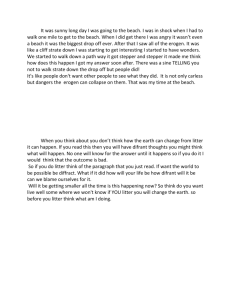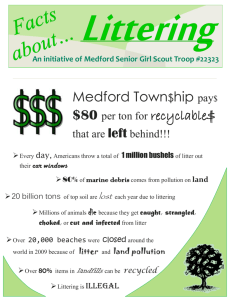LITTER DETECTIVES
advertisement
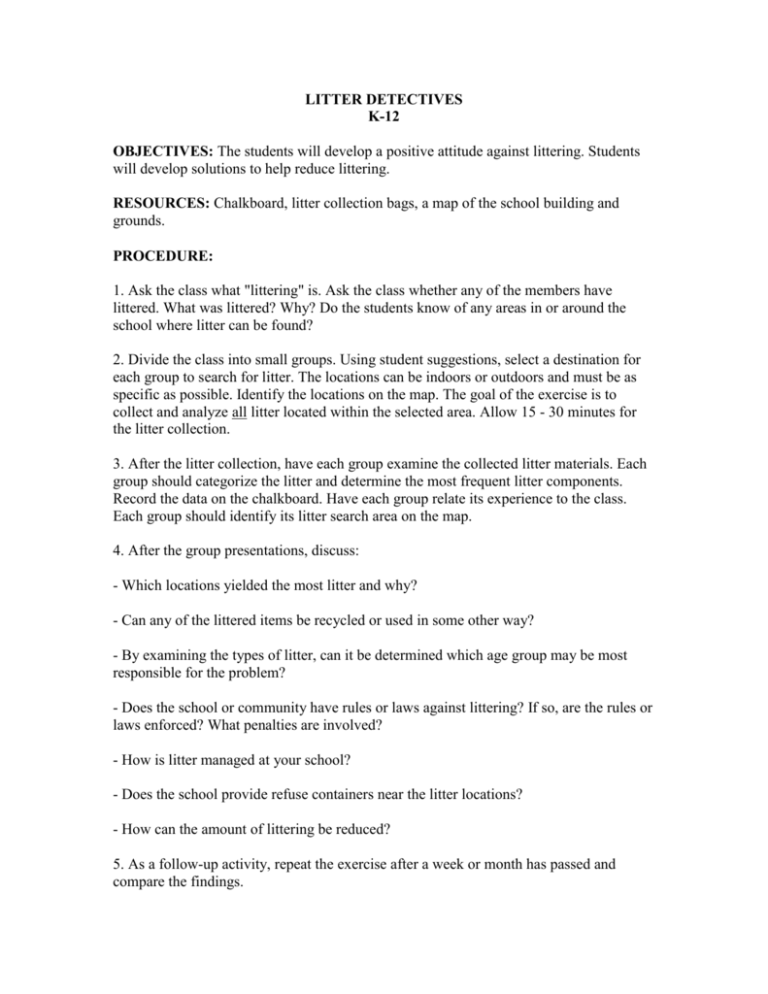
LITTER DETECTIVES K-12 OBJECTIVES: The students will develop a positive attitude against littering. Students will develop solutions to help reduce littering. RESOURCES: Chalkboard, litter collection bags, a map of the school building and grounds. PROCEDURE: 1. Ask the class what "littering" is. Ask the class whether any of the members have littered. What was littered? Why? Do the students know of any areas in or around the school where litter can be found? 2. Divide the class into small groups. Using student suggestions, select a destination for each group to search for litter. The locations can be indoors or outdoors and must be as specific as possible. Identify the locations on the map. The goal of the exercise is to collect and analyze all litter located within the selected area. Allow 15 - 30 minutes for the litter collection. 3. After the litter collection, have each group examine the collected litter materials. Each group should categorize the litter and determine the most frequent litter components. Record the data on the chalkboard. Have each group relate its experience to the class. Each group should identify its litter search area on the map. 4. After the group presentations, discuss: - Which locations yielded the most litter and why? - Can any of the littered items be recycled or used in some other way? - By examining the types of litter, can it be determined which age group may be most responsible for the problem? - Does the school or community have rules or laws against littering? If so, are the rules or laws enforced? What penalties are involved? - How is litter managed at your school? - Does the school provide refuse containers near the litter locations? - How can the amount of littering be reduced? 5. As a follow-up activity, repeat the exercise after a week or month has passed and compare the findings. WASTE WHERE DOES IT COME FROM? WHERE DOES IT GO? K-12 OBJECTIVES: The students will identify the various waste materials generated in the school. They will describe the sequence of collection and the destination of the materials identified. RESOURCES: Classroom wastebasket, maintenance personnel, area road map, chalkboard. PROCEDURE: 1. Separate the class into three groups. 2. Have group one examine the contents of the classroom wastebasket. Ask the group to identify the various types of waste materials generated in the classroom. Categorize the waste materials as paper products, glass, metals, plastics, organic wastes, etc. Record the findings on the chalkboard. 3. The second group should examine the flow of the waste materials after they are collected from the classroom. This may require an interview with maintenance personnel. Are the wastes consolidated with other classroom's wastes? Why? Are the wastes transferred to a large capacity receptacle? Are any wastes burned in a school incinerator? Are any waste materials recycled? If wastes are collected from the school by the municipality or a commercial disposal firm, where are the wastes disposed? 4. Have the third group determine the types of wastes generated in special subject areas of the school (arts and crafts, gym, home economics, industrial arts, etc.), the school cafeteria, the office, the maintenance area. Are these wastes handled in the same manner as classroom wastes? Determine what other wastes are generated by the school. Where do these wastes go? 5. Regroup the class. Have a member or members of each group report the group findings, beginning with group one. Create a diagram or a flowchart on the chalkboard to outline the reports of groups two and three, indicating the steps between waste generation and waste disposal. 6. Ask whether any members of the class live near or have visited a landfill, an incinerator, a recycling center, or a sewage treatment plant. Ask for descriptions and impressions of the facilities. Determine whether any of these facilities are located near the school. You may need to contact your county planning department for the locations. Plot the facility locations and the school location on the road map. Calculate the distances that waste materials must be transported to each facility. List the type of wastes generated by the school which are managed by each facility and the distance of each facility from the school. 7. (Optional) Arrange a class field trip to one or more waste management facility. Create a class record for each facility. Include photos, drawings, essays, and audio or video tape recordings. Invisible Water Pollution To help students understand that clear water isn't necessarily free of pollutants, place 5 clear liquids in portion cups. Things to include should have a definite taste that students would recognize. Use sugar water, white vinegar, salt water, water mixed with citric acid, and tap water. Using cotton swabs, have students taste each liquid (dispose of swab after each taste) and record what they taste after each. After students have all had a chance to taste, discuss that some kinds of pollution can't be seen. If you have local creeks, streams, or other water ways that are unsafe for human use, this is a good jumping off point to discuss the problems these bodies of water have.

